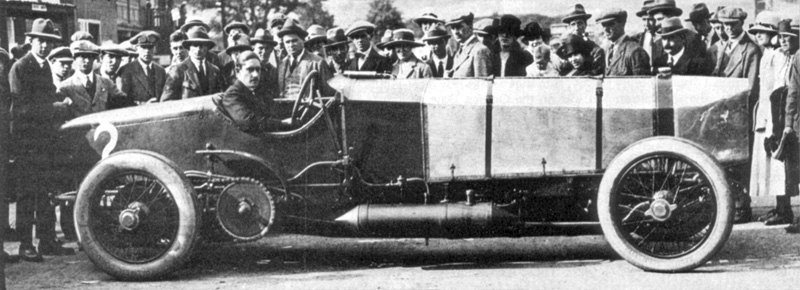
Our top chap this week is Count Louis Zborowski in Chitty-Bang-Bang (oh yes!) at Brooklands in 1921. It’s fashionable now for sons of racers to take up the old-man’s trade. But Louis Zborowski may well have been the first.
14-Sep-22 Chris Bowen
His father, Count Eliot Zborowski of Poland, drove for the Mercedes factory team in the early 1900s. Unfortunately though, he rolled his car during the 1903 La Turbie hillclimb and terminated his contract with immediate effect.
Brought up by his American mother at Higham Park house in Kent, the boy Louis not only inherited his father’s enthusiasm for motoring, but also his vast wealth with which to indulge himself.
And indulge, he did. Chitty-Bang-Bang (just the one Chitty) was created for the 1921 season as an “Outer-Circuit” Brooklands car. And combined a lengthened, 1907, chain-drive Mercedes chassis, with a 23-litre Maybach aero-engine from a German Gotha bomber.
Louis originally planned to call the car Cascara Segrada, after a spectacularly powerful laxative. But the Brooklands authorities took exception and refused to except the entry! The new name though, was, if properly understood, possibly even ruder! It came from WW1 army slang for a pass (chitty) that gave access to the local town for “nocturnal recreation” (bang-bang!). More sensitive souls though, were convinced that it mimicked the sound of the engine.
The car was a great success on the track, and Louis and his team of upper-class mechanics and hangers-on became a popular feature of the fashionable Brooklands “set”.
Two further Chitty-Bang-Bangs followed. Chitty 2, built later the same year, had a 19-Litre Benz engine mounted in a similar chassis. But with a 4-seater bodywork for touring rather than racing (in 1922, Louis had it shipped it to Algeria to take a group of friends on an successful expedition into the Sahara desert!).
Chitty 3, which appeared in 1922, was however another racing car. More modern and sophisticated than Chitty 1, and endowed with a 15- litre Mercedes engine. The Count was also one of the few British drivers of the 1920s take on the dastardly foreigners at their Grand Prix racing.
Initially as a patron of Lionel Martin’s fledgling Aston Martin outfit, before accepting an offer from Mercedes (Their union with arch-rivals Benz, was still two years away) to follow in his father’s footsteps as a member of their factory team for the 1924 season.
What happened next was, in the great Friday Chaps tradition, too predictable by half. In the Italian Grand Prix at Monza, he took an unscheduled excursion into the woods. And, before he knew it, he’d be shaking hands with his dear-old Dad.
He was just twenty-nine years old. Louis’ legacy, apart from the significant role he played in helping to establish Aston Martin, would be his cars. Including two unfinished projects. Chitty 4, and the 27-Litre Higham Special. And of all things, The Romney, Hythe and Dymchurch miniature steam railway. Of which he was one of the founders!
Chitty 1 was sold to the motor racing sons of Arthur Conan-Doyle, who left it lying derelict in a corner of Brooklands until it was broken-up out of sheer disinterest.
Chitty 2 still exists (picture below), and has lived for many years in the USA.
While Chitty 3 continued to be raced by it’s various owners up until 1939. After which, it too was broken-up.
Chitty 4 was never finished and disappeared.
The Chitty-Bang-Bang story was then largely forgotten. That was until Ian Fleming published his famous Chitty-Chitty-Bang-Bang (with an extra Chitty!) book in 1964.
Despite it’s success though, this book was, in our opinion, a very poorly researched historical record. Not only did he make no effort at all to get the names right, but it’s absolutely brimming with factual inaccuracies. None of the Chitty-Bang-Bang cars, for example, ever demonstrated any tendency to fly or float. And the suggestion that Louis Zborowski’s father, the old Count, lived in his garden shed, is frankly just absurd. In fact, if you’re honest, it was almost as if Ian Fleming had written the whole thing just for kids!
The unfinished Higham Special however, would become famous in it’s own right. Bought and completed by fellow Brooklands racer John Parry-Thomas, for World Land Speed Record work, it famously “did” for it’s new owner on the moist wastes of Pendine Sands. This is a whole story in itself, but the car still exists, and is better known today by it’s nickname…. “Babs”.